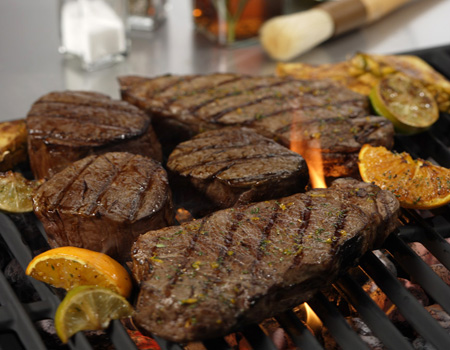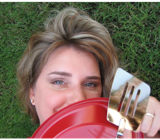
I LOVE movies — don’t you? You can lose yourself in a movie, expand your mind, or just laugh for a moment.
Super Chef Sister-in-Law Sandy is here today with her experience with the movie Moonstruck.
It involves steak, mad love and iron intake.
Intrigued? Read on . . .
One of my favorite movies is Moonstruck, with Nicolas Cage and Cher starring as a couple of Italians living in Little Italy in New York City who fall in love, despite some obstacles. It is kind of a foodie movie, in that much of the dialogue/action revolves around the dinner table. The two of them begin as pretty violent adversaries, and then she cooks him a steak so that they can have a civilized discussion about a family rift.
There are several interesting things about the scene that really resonate with me — the first of course being that a meal is a way to bring people together. I am definitely a food equates to love kind of girl — a meal together is really one of the most joyous ways to get together. I enjoy having a meal together with family or friends, and I think that preparing food together is such an intimate way to get to know people. It just feels comfortable working together. Think of all those awkward dates in college when you were waiting for the waiter or waiting for the food to come. Nothing to do, nervous… yuck! Making something from your kitchen is really a way to show people that you like them.
Another thing that I find really funny about the scene is that Cher does what she thinks is best for his character, despite what he wants. “I’m not hungry,” he says and she replies that she is cooking him a steak. “I like it well done,” he says. And she says, “You’ll eat it bloody to feed your blood.” When the food is prepared, he grunts, “It’s good.” They eat together and work out their issues.
When I watched this again the other day, I wondered about the line “You’ll eat it bloody to feed your blood.” From my college nutrition class, I remembered a few things about iron absorption, but not anything specifically about doneness related to iron levels. So after a bit of research on the Internet, I came up with a controlled study done by the Institute of Food, Nutrition and Human Health, Massey University, New Zealand. Their conclusion was that cooking beef indeed did change some of the soluble form of iron in beef to insoluble, and a greater doneness meant that more of the iron was converted to an insoluble (therefore unusable) form for human consumption. They did conclude, though, that despite these changes with cooking, beef remains a good source of iron and a useful source of the potentially bioactive compounds taurine, carnosine, coenzyme Q10 and creatine.
If you want to maximize the amount of usable iron you get from any meal, it is important to limit tannins (found in tea, red wine and other sources) taken at the same meal, and instead enjoy your steak with some vitamin C. How about a nice glass of lemonade or water with a splash of lime? Also, if you eat other foods like beans, which are a good source of iron also, the steak will help you absorb iron from the other foods.
When my son was a toddler, his pediatrician diagnosed a mild iron deficiency in him. After my first taste of the supplement recommended to me for him I knew I’d have to find a way to get his iron intake up from food sources — iron supplements taste awful, worse than any other medicine I have ever taken myself.
At the time I did lots of research into what I could to increase his iron absorption from food. One of the simplest ways that you can increase the amount of iron in your diet is to use cast iron to cook with. Believe it or not, a bit of the iron from the cooking vessel actually imparts itself into whatever you cook in it. Another easy way to get iron in him was in the hot cereals aisle. Check out some of the iron levels in those cereals. I even used some of the boxed cereals to make muffins and baked goods — you can hide a lot of goodness in a banana chocolate chip muffin. Now he is the biggest steak eater in the family, so not so much a problem anymore.
If you have questions about the iron levels in your blood or in your diet, please consult your health professional. I just think it’s interesting to know the little things that we can do to increase the nutritional benefits from the food that we eat. Enjoy your steak – it’s health food!
Nutrition Facts |
| The recommended dietary allowance (RDA) for iron in healthy adults is 10 milligrams per day for men and 15 milligrams per day for premenopausal women. Premenopausal women’s needs are higher than men’s needs because women lose iron during menstruation.
It is generally easier for men to get enough iron than it is for women. Because they are usually bigger, men have higher calorie needs and will most likely eat enough food to meet their iron requirements. Women, on the other hand, tend to eat less. This makes it more difficult for them to meet their iron needs. It is, therefore, particularly important for premenopausal women to eat foods high in iron. Pregnant women will need as much as 30 milligrams of iron per day. The main reason is because the unborn baby needs iron for development. As a result, it will draw from the mother’s iron stores. This can quickly deplete a woman of iron if she is not eating enough iron rich foods.In general, meat, fish, and poultry are excellent sources. Other sources of iron include beans, dried fruits, whole grains, fortified cereals, and enriched breads. Iron is a mineral essential for life. Found in red blood cells, iron’s primary role is to carry oxygen from the lungs to the rest of the body. Without oxygen, the body’s cells cannot function normally. If the body’s iron stores become too low, an iron-deficiency anemia can occur. This is characterized by weakness, lethargy, muscle fatigue, and shortness of breath. In severe cases, a person’s skin may become pale due to a lack of red blood cells in the body. |
Source: http://www.calories-nutrition.buddyslim.com/beef-steak/
Photo courtesy of SmackAMack.wordpress.com.

